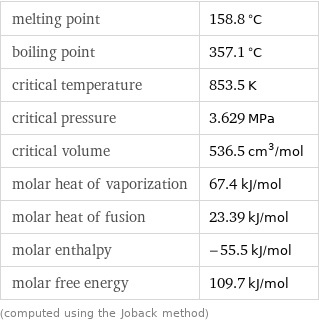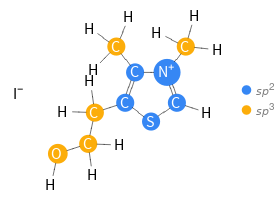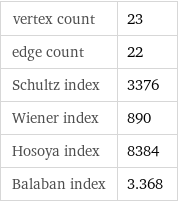Input interpretation

5-(2-hydroxyethyl)-3, 4-dimethylthiazolium iodide
Basic properties
![molar mass | 285.1 g/mol formula | C_7H_12INOS empirical formula | I_O_C_7N_S_H_12 SMILES identifier | CC1=C(CCO)SC=[N+]1C.[I-] InChI identifier | InChI=1/C7H12NOS.HI/c1-6-7(3-4-9)10-5-8(6)2;/h5, 9H, 3-4H2, 1-2H3;1H/q+1;/p-1/fC7H12NOS.I/h;1h/qm;-1 InChI key | GDNOYVMHHMSZJV-UHFFFAOYSA-M](../image_source/767b512497053491b219f0cb72e76d92.png)
molar mass | 285.1 g/mol formula | C_7H_12INOS empirical formula | I_O_C_7N_S_H_12 SMILES identifier | CC1=C(CCO)SC=[N+]1C.[I-] InChI identifier | InChI=1/C7H12NOS.HI/c1-6-7(3-4-9)10-5-8(6)2;/h5, 9H, 3-4H2, 1-2H3;1H/q+1;/p-1/fC7H12NOS.I/h;1h/qm;-1 InChI key | GDNOYVMHHMSZJV-UHFFFAOYSA-M
Structure diagram

vertex count | 11 edge count | 11 Schultz index | 488 Wiener index | 119 Hosoya index | 96 Balaban index | 2.334
Estimated thermodynamic properties

melting point | 158.8 °C boiling point | 357.1 °C critical temperature | 853.5 K critical pressure | 3.629 MPa critical volume | 536.5 cm^3/mol molar heat of vaporization | 67.4 kJ/mol molar heat of fusion | 23.39 kJ/mol molar enthalpy | -55.5 kJ/mol molar free energy | 109.7 kJ/mol (computed using the Joback method)
Units

Quantitative molecular descriptors

longest chain length | 7 atoms longest straight chain length | 3 atoms longest aliphatic chain length | 2 atoms aromatic atom count | 5 atoms H-bond acceptor count | 1 atom H-bond donor count | 1 atom
Elemental composition

Find the elemental composition for 5-(2-hydroxyethyl)-3, 4-dimethylthiazolium iodide in terms of the atom and mass percents: atom percent = N_i/N_atoms × 100% mass percent = (N_im_i)/m × 100% Plan: • Write the chemical formula and gather atomic masses from the periodic table. • Determine values for N_i, m_i, N_atoms and m using these items. • Finally, compute the percents and check the results. Write the chemical formula: C_7H_12INOS Use the chemical formula to count the number of atoms, N_i, for each element and find the total number of atoms, N_atoms, per molecule: | number of atoms I (iodine) | 1 O (oxygen) | 1 C (carbon) | 7 N (nitrogen) | 1 S (sulfur) | 1 H (hydrogen) | 12 N_atoms = 1 + 1 + 7 + 1 + 1 + 12 = 23 Divide each N_i by N_atoms to calculate atom fractions. Then use the property that atom fractions must sum to one to check the work: | number of atoms | atom fraction I (iodine) | 1 | 1/23 O (oxygen) | 1 | 1/23 C (carbon) | 7 | 7/23 N (nitrogen) | 1 | 1/23 S (sulfur) | 1 | 1/23 H (hydrogen) | 12 | 12/23 Check: 1/23 + 1/23 + 7/23 + 1/23 + 1/23 + 12/23 = 1 Compute atom percents using the atom fractions: | number of atoms | atom percent I (iodine) | 1 | 1/23 × 100% = 4.35% O (oxygen) | 1 | 1/23 × 100% = 4.35% C (carbon) | 7 | 7/23 × 100% = 30.4% N (nitrogen) | 1 | 1/23 × 100% = 4.35% S (sulfur) | 1 | 1/23 × 100% = 4.35% H (hydrogen) | 12 | 12/23 × 100% = 52.2% Look up the atomic mass, m_i, in unified atomic mass units, u, for each element in the periodic table: | number of atoms | atom percent | atomic mass/u I (iodine) | 1 | 4.35% | 126.90447 O (oxygen) | 1 | 4.35% | 15.999 C (carbon) | 7 | 30.4% | 12.011 N (nitrogen) | 1 | 4.35% | 14.007 S (sulfur) | 1 | 4.35% | 32.06 H (hydrogen) | 12 | 52.2% | 1.008 Multiply N_i by m_i to compute the mass for each element. Then sum those values to compute the molecular mass, m: | number of atoms | atom percent | atomic mass/u | mass/u I (iodine) | 1 | 4.35% | 126.90447 | 1 × 126.90447 = 126.90447 O (oxygen) | 1 | 4.35% | 15.999 | 1 × 15.999 = 15.999 C (carbon) | 7 | 30.4% | 12.011 | 7 × 12.011 = 84.077 N (nitrogen) | 1 | 4.35% | 14.007 | 1 × 14.007 = 14.007 S (sulfur) | 1 | 4.35% | 32.06 | 1 × 32.06 = 32.06 H (hydrogen) | 12 | 52.2% | 1.008 | 12 × 1.008 = 12.096 m = 126.90447 u + 15.999 u + 84.077 u + 14.007 u + 32.06 u + 12.096 u = 285.14347 u Divide the mass for each element by m to calculate mass fractions. Then use the property that mass fractions must sum to one to check the work: | number of atoms | atom percent | mass fraction I (iodine) | 1 | 4.35% | 126.90447/285.14347 O (oxygen) | 1 | 4.35% | 15.999/285.14347 C (carbon) | 7 | 30.4% | 84.077/285.14347 N (nitrogen) | 1 | 4.35% | 14.007/285.14347 S (sulfur) | 1 | 4.35% | 32.06/285.14347 H (hydrogen) | 12 | 52.2% | 12.096/285.14347 Check: 126.90447/285.14347 + 15.999/285.14347 + 84.077/285.14347 + 14.007/285.14347 + 32.06/285.14347 + 12.096/285.14347 = 1 Compute mass percents using the mass fractions: Answer: | | | number of atoms | atom percent | mass percent I (iodine) | 1 | 4.35% | 126.90447/285.14347 × 100% = 44.51% O (oxygen) | 1 | 4.35% | 15.999/285.14347 × 100% = 5.611% C (carbon) | 7 | 30.4% | 84.077/285.14347 × 100% = 29.49% N (nitrogen) | 1 | 4.35% | 14.007/285.14347 × 100% = 4.912% S (sulfur) | 1 | 4.35% | 32.06/285.14347 × 100% = 11.24% H (hydrogen) | 12 | 52.2% | 12.096/285.14347 × 100% = 4.242%
Elemental oxidation states

The first step in finding the oxidation states (or oxidation numbers) in 5-(2-hydroxyethyl)-3, 4-dimethylthiazolium iodide is to draw the structure diagram. Next set every oxidation number equal to the atom's formal charge: In 5-(2-hydroxyethyl)-3, 4-dimethylthiazolium iodide hydrogen is not bonded to a metal with lower electronegativity, so it will have an oxidation state of +1. Any element bonded to hydrogen gains the bonding electrons, decreasing their oxidation state by 1 for every bond: With hydrogen out of the way, look at the remaining bonds. There are 3 carbon-nitrogen bonds, 1 carbon-oxygen bond, 2 carbon-sulfur bonds, and 4 carbon-carbon bonds. For each of these bonds, assign the bonding electrons to the most electronegative element. First examine the carbon-nitrogen bonds: element | electronegativity (Pauling scale) | C | 2.55 | N | 3.04 | | | Since nitrogen is more electronegative than carbon, the electrons in these bonds will go to nitrogen. Decrease the oxidation number for nitrogen in every highlighted bond (by 1 for single bonds, 2 for double bonds, and 3 for triple bonds), and increase the oxidation number for carbon accordingly: Next look at the carbon-oxygen bond: element | electronegativity (Pauling scale) | C | 2.55 | O | 3.44 | | | Since oxygen is more electronegative than carbon, the electrons in this bond will go to oxygen: Next look at the carbon-sulfur bonds: element | electronegativity (Pauling scale) | C | 2.55 | S | 2.58 | | | Since sulfur is more electronegative than carbon, the electrons in these bonds will go to sulfur: Next look at the carbon-carbon bonds: element | electronegativity (Pauling scale) | C | 2.55 | C | 2.55 | | | Since these elements are the same the bonding electrons are shared equally, and there is no change to the oxidation states: Now summarize the results: Answer: | | oxidation state | element | count -3 | C (carbon) | 1 | N (nitrogen) | 1 -2 | C (carbon) | 2 | O (oxygen) | 1 | S (sulfur) | 1 -1 | C (carbon) | 1 | I (iodine) | 1 +1 | C (carbon) | 2 | H (hydrogen) | 12 +2 | C (carbon) | 1
Orbital hybridization

hybridization | element | count sp^2 | C (carbon) | 3 | N (nitrogen) | 1 | S (sulfur) | 1 sp^3 | C (carbon) | 4 | O (oxygen) | 1
Structure diagram

Orbital hybridization Structure diagram
Topological indices

vertex count | 23 edge count | 22 Schultz index | 3376 Wiener index | 890 Hosoya index | 8384 Balaban index | 3.368